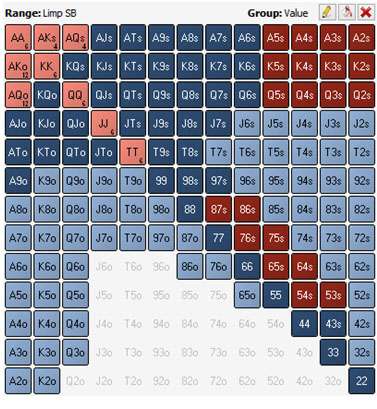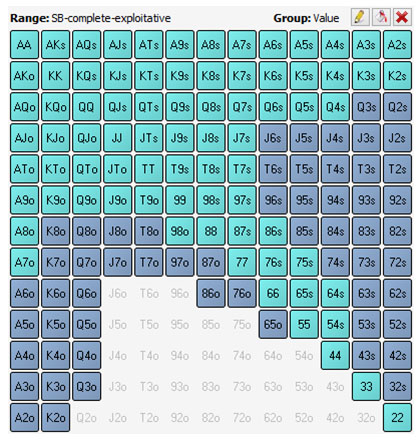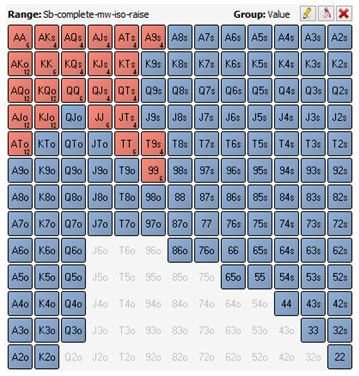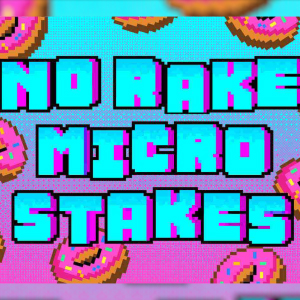Completing in the small blind instead of raising has been the latest trend in some of the high stakes cash games. This is a strategy that good regs are starting to use in order to be able to play a wider range in the SB, as high as 70%. In addition to this, it puts a BB in a spot where they are forced to play any two cards, which we can take advantage of.
New Small Blind Trends
There is a

new trend taking place at the higher limit games. Completing in the SB as opposed to raising. Why is this happening? How can we apply the concepts to lower limit games?
The primary reason behind the adjustment is that it allows us to play a wider
range in the SB. It's typically considered that when following a
raise-first-in strategy from the SB, we can raise about 36% of hands without becoming exploitable by the BB. Completing takes better advantage of the blind structure and allow us to play a 70% range while still retaining the ability to construct a balanced defense vs aggression. Playing more hands profitably simply means we can increase the overall profitability of this situation.
In practical terms, think of how annoying it is when we open in the SB and face a ton of 3bets from an aggressive BB. We realise that we need to make a defense but we also don't relish the idea of 4-betting or attempting to play postflop OOP in a 3bet pot. By completing we take away a ton of our opponent's firepower. Firstly we play against his entire range since he has no option to fold, and secondly the worst he can do is raise to something like 4bb. We'll likely have a much easier time defending in this situation as opposed to playing OOP in a 3bet pot.
How does it work?
We'll start by considering the GTO based version which is used for the higher limit games and then consider how we can modify the
poker strategy for use at the lower limit games.
When playing the GTO version of this strategy we have zero raising range from the SB. That means we complete everything that we decide to play, including pocket Aces. If our opponent decides to check-back then we will see a flop with our entire 70% completing range. Assuming our opponent decides to raise vs our SB complete then we have 3 options. We have a range of hands that limp/call, a range of hands that limp/raise and a range of hands that limp/fold. Our limp/raising range will naturally include our premium holdings but we will also include a balanced amount of bluffs.
Naturally the true
GTO solution to this situation remains unknown until the day that poker is solved – but as a rough idea it's going to look something like this --->

The selected hands here represent roughly a 70% range. These are the hands that will open-limp when following a balanced strategy.
- The hands in the light-red colour are our value limp-raises.
- The hands in the dark-red colour are our bluff limp-raises.
- The hands in the dark-blue are our limp-calling hands.
- The hands in the light-blue are our limp-folding hands.
Usage at Lower Limits
While the above strategy would do reasonably well at lower limits, it's likely not optimal for a couple of reasons.
The first issue is that we possibly don't want to be limping our premium holdings vs the majority of players at lower limits. We simply make more money by going immediately for value with a raise.
The second issue is that many players are not defending their BB optimally vs a SB open. In many cases they are folding too much and we really want to take advantage of this with a raise. If we open-limp in the SB we have no fold-equity.
So ideally we would like a strategy that has all the advantages of being able to play a wider range while still incorporating the exploitative features of a raise-first-in strategy.
Exploitative Completing Strategy
The following strategy can be considered as a result –>

The light green represents a standard rfi range from the SB; we can continue to open-raise this. The blue colour represents the hands we play a completing strategy with.
The immediate problem with this range is that any time we open-limp from the SB we are going to have zero strong hands. This is only actually a problem if opponent recognizes this however. If he is passive and checks back a ton we will simply be able to see a ton of flops with hands we would have otherwise open-folded.
If our opponent does recognize the imbalance in our game then he is also good enough that we can potentially be using the more balanced version of this strategy against him. It's not a bad situation if our opponent assumes we are weak after we limp and we have AA.
We also want to pay close attention to our opponent's fold-to-steal stat. If this is noticeably above 60% we should probably think about ditching the completing strategy since we can actually open-raise exploitatively with a 100% range. Completing likely doesn't confer any additional advantage when we can already play 100% of our holdings.
Expanding Limping Range
Although completing in the SB was not considered by most players before a couple of years ago, there were some exploitative situations where good players would consider open-limping.
In particular imagine a situation where we are in the SB and deciding whether to raise against the BB who is a huge
fish with 40bb stacks. We hold J4o. Raise or fold here? The problem with raising is that we possibly have no
fold-equity preflop. Our opponent will call most of the time and we will simply be building a pot OOP with J-high when the stacks are shallow. When we do hit a strong hand the 40bbs are not enough to make up for the risk we took preflop. It's hard to see raising being a profitable long-run decision.
So what about folding here? Folding would certainly be reasonable and likely the option that most would choose. However it's also true that we want to spend as much time as possible playing pots against the fish. We have a perfect opportunity here to play HU vs a bad opponent and we are simply going to open-fold.
So the compromise here? Open-limp in the SB. We will get to see a flop most of the time and we have not invested much money to get to that situation. Now assuming we hit something reasonable the money in the middle is enough to compensate us for our preflop investment.
We want to spend as much time as possible playing against the fish!
So the next question is, what about those hands which are not included in the above grid? 83o for example. Always still a fold? Not at all, especially if the stacks are reasonably deep. Our postflop edge should be enough against very bad players that we can potentially open-limp anything. Naturally against fish we would continue to raise our 36% raise-first-in range, but we can pretty much open limp anything else. This way we are playing 100% range vs the fish, and taking every opportunity available to play against a bad player.
Postflop Play
Assuming our opponent

checks back the BB after we complete we should be reasonably content to
lead aggressively on the flop. The reason for this is that BB often starts out with a weak range. If he had something decent preflop he would often raise. We don't need to fire the flop with 100% frequency but even marginal potential should be enough for a bluff-lead. This way we still get a chance at some fold-equity (we missed out on some preflop), but this time we have a little bit of a stronger idea regarding our opponent's range.
Assuming we limp/call we will typically be checking the flop to the preflop aggressor. We should be prepared to play aggressively and fight for pots. The situation is not dissimilar to defending from the blinds as cold-caller vs a late position open. We should be taking high potential hands to use as check/call
floats, and check/raise bluffs.
Assuming we limp/raise, the situation is very similar to playing in a 3bet pot OOP after we 3bet vs a LP opener. The main difference is that readless, a good reg will often be giving you a decent amount of credit for AA/KK. As a result we can rep a much stronger range than we typically can with a standard 3bet OOP and can generate more fold-equity as a result. We should also give our opponent more credit if he plays back at us since our range should be perceived as stronger and our opponent is less likely to bluff as a result.
Multi-way Preflop
For a while it was very common to hear the advice “never limp, always come in for a raise”. In many cases this holds true. For example it's not recommended to open limp in pretty much any other position than the SB. Limping behind can sometimes be considered, but frequently there will be a better option.
This old piece of strategy advice very often blinds people to an obvious play in the SB. 2 or more players limp and we have the opportunity to complete and play in a multi-way limped pot, or simply fold preflop. The
pot-odds we get in this situation are insane. Also we are nearly always guaranteed to be playing against one or more fish because good regulars typically don't open-limp. This is essentially going to be a no-brainer call with a very wide and weak range.
Players very often in this situation -
- Fold too much because they've heard limping is bad
- Iso-raise with a range that is too wide because they've heard limping is bad
Limping here is great. Here is a possible range.

In the red we have our iso-raising range. Notice it's pretty tight. We don't even have to iso-raise this wide. Iso-raising is considerably less profitable OOP compared to IP. IP we can significantly expand this range.
However notice that this does not mean we are folding a ton either. We are playing a 70% range here again. We should be completing extremely wide when we get excellent pot odds and the opportunity to play vs weaker opponents.
Effects on Strategy
Since even many good regulars do not yet understand or utilise the above concepts, there is a very good chance we will end up playing a different style of poker to the other regs at our table. Here are some noticeable differences.
Firstly our VPIP/PFR will be different. Playing nearly twice as many hands from the SB as the average reg will have a noticeable effect on our VPIP/PFR. Our VPIP will increase. Assuming we use a more balanced strategy in the SB and cut out some of our raise-first-in range our PFR may potentially decrease. So if formerly we were playing something like 25/20 vpip/pfr we shouldn't be surprised if we are now playing 27/18 or something similar.
Secondly many regulars may
automatically assume we are fish. And it's a pretty reasonable assumption. In fact, if we are in the BB and someone completes in the SB, our first reaction should be that they are a fish. It's simply more likely that they are a fish as opposed to a good regular employing a completing strategy. Most regs don't know about this strategy yet. It does however mean that regs may be attempting to
iso-raise us aggressively with a wide range. This can sometimes bring additional benefits to limping premium holdings as part of an exploitative strategy.
In fact, if we are in the BB and someone completes in the SB, our first reaction should be that they are a fish. It's simply more likely that they are a fish as opposed to a good regular employing a completing strategy.
Thirdly it should be possible to increase our SB winrate to one which would be considered very high by previous standards. In the past with our standard RFI strategy we were looking attain a SB winrate of around -15bb/100. It should now be possible to get -8bb/100 hands using the new strategies effectively.
 new trend taking place at the higher limit games. Completing in the SB as opposed to raising. Why is this happening? How can we apply the concepts to lower limit games?
new trend taking place at the higher limit games. Completing in the SB as opposed to raising. Why is this happening? How can we apply the concepts to lower limit games?




